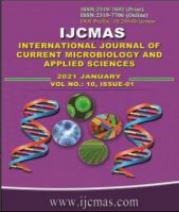


 National Academy of Agricultural Sciences (NAAS)
National Academy of Agricultural Sciences (NAAS)

|
PRINT ISSN : 2319-7692
Online ISSN : 2319-7706 Issues : 12 per year Publisher : Excellent Publishers Email : editorijcmas@gmail.com / submit@ijcmas.com Editor-in-chief: Dr.M.Prakash Index Copernicus ICV 2018: 95.39 NAAS RATING 2020: 5.38 |
Throughout the world more than 2 billion people affect due to micronutrient deficiency or hidden hunger, among them women and children put up with more because of their physiological needs. Impaired immune function, complications in pregnancy and childbirth, poor child growth as well as learning disability happen due to Iron and zinc deficiencies. Rice is the staple food of more than half the world’s population and since ancient time it is being cultivated in Asia. Considering the importance of rice as dietary source and to fight back against micronutrient deficiency, in the present study the Zn, Fe and Ca content has been analyzed in 45 different folk rice along with some HYVs and hybrid rice. Out of the 45 different folk rice genotypes 25 were aromatic and 20 were non-aromatic in nature. These were evaluated with three high yielding varieties and two hybrid varieties to determine ways to conserve these indigenous genotypes ex-situ in active participation of such experienced farmers at Gontra village, Chakdah, Nadia, West Bengal. All the genotypes were evaluated during kharif season of 2017 and 2018 in Randamised Block Design in three replications following standard agronomic practices. Seed yield among the indigenous genotypes ranged from 227.33g m-2(Tulsimanjari) to 550 g m-2 (Chamarmani). Other genotypes which recorded comparatively superior performance were Sitashal (525.17g m-2), Kedargouri (525.33g m-2), Tilakkati (514 g m-2), Langalmuthi (513.07 gm-2), Dudkhas (508.33 g m-2), Dadshal(497 g m-2), Kalma (485.33 g m-2), Kanakchur (471 g m-2), Tulaipanji (471.67 g m-2), Chinikamini (462 g m-2), Chinigura (459.33 g m-2),Chinapakri (485 g m-2). The standard semi-dwarf check variety IET-4786 (Satabdi) and IET-4094 (Kshitish) recorded 602.33 and 608.33 g m-2. Morphological analysis revealed that among the tested genotypes the length varied from 5.13 mm to 10.13 mm, the breadth varied from 1.50 mm to 3.40 mm. Common cultivars contain about 12 mg Fe kg-1and around 25 mg Zn kg-1 but some traditional varieties were found to possess those micronutrients in double amounts. It is interesting to note that the indigenous genotypes were rich in micro-nutrient compared to HYVs and hybrids tested in the study. Highest iron contents was found in Sonajhuli (70.30ppm) whereas highest calcium content was revealed in Chinigura (196.75ppm) and highest zinc content was recorded in Raghushal (26.45ppm). It is suggested that the indigenous genotypes having considerably high micro-nutrients like Fe, Zn, Ca may be considered as high value rice genotypes. The potentiality of these genotypes might be exploited further due to its commercial importance or through the utilization of their gene pool in the area of plant breeding to combat the hidden hunger.
 |
 |
 |
 |
 |